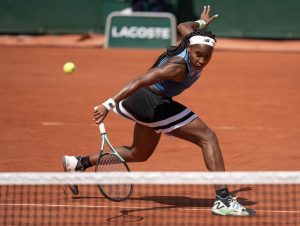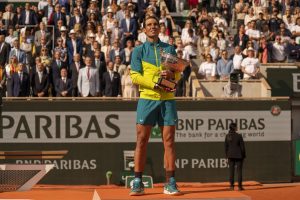As we wait for professional tennis to start up again, we here at LWOT are looking back on some historic matches, including some of the biggest blowouts involving the Big Three. Up next, a short trip down memory lane to the most recent edition of the ATP Finals.
Roger Federer and Novak Djokovic’s rivalry, though extensive, has featured few blowouts. Even when Federer has made a sharp start against the Serb, such as in Cincinnati in 2012 when he won the first set to love, he has been pegged back thereafter. Strange as it may seem then, his most decisive win over his great rival may well have come in their 49th meeting in the round-robin stage at the 2019 ATP Finals in London.
Heading into the match the Swiss had not beaten Djokovic in four years, although they had met on just four occasions with both spending time sidelined through injury. But despite playing having played relatively infrequently, Federer was carrying no shortage of mental baggage, not least because Djokovic had beaten him from two match points down in the final at the All England Club that July. There were fears that the heartbreaking nature of that defeat might play on his mind at the O2 Arena.
Dominic Thiem had, to the surprise of most, secured top spot in the group by beating Federer and then Djokovic, setting up a three-set shootout for a berth in the semifinals between the Swiss and the Serb. The question was: would Federer crack under the pressure?
The match
The first game of the match was not entirely encouraging for fans of Federer. He did create a break point, but Djokovic saved it with a fine inside out forehand, before sealing the hold thanks to a shanked Federer backhand. With an inability to convert break points and a backhand still prone to breaking down, despite the switch to a larger racquet face, having plagued Federer throughout the latter stages of his career, there were reasons to be concerned.
But Federer put those concerns to rest in emphatic fashion, with the assistance of an off-colour Djokovic. Poor play from the Serbian saw Federer take a 0-30 in the third game of the match and Federer took full advantage of the opening offered by his opponent. Two superbly measured backhands proved too good for Djokovic to control and Federer took an early lead with a break to love. It was a lead he would not relinquish.
Djokovic is unquestionably one of the greatest returners in the history of the sport, but Federer’s spot serving was exceptional. Djokovic made just six returns in the set. And even when the then-world #2 did manage to get his racquet on the ball, it was to little avail. Federer was in dominant mood from the baseline, punishing anything Djokovic left short and hitting winners from all over the court. One particularly impressive forehand winner hit on the run in the tenth game had Djokovic beaten all ends up.
Federer sealed the set shortly thereafter and when he forced two break points in the first game of the second set, the match looked all but over. But Djokovic dug in, saving the break points before battling to deuce in Federer’s next service game. Slowly but surely he looked to be turning the match around and in the fourth game of the set, Djokovic forced his first break point of the match. Federer, however, was in no mood to be denied.
He drilled an inside-in forehand onto the line, before rushing the net and putting away a simple volley. It proved to be the decisive moment. Djokovic did not get close to the Federer serve again and looked tired, mentally and physically. In the next game, uncharacteristic errors from the Djokovic racquet gave Federer two break points and he took the first, as Djokovic sent a forehand beyond the baseline under pressure. That left Federer just three holds from victory.
But Djokovic proved unable to even ask the serve it out question. Down 4-6 3-5, the great Serbian found himself in a 0-40 hole. In desperation he served and volleyed, but Federer’s blocked return forced him to volley on the stretch. The ball did not clear the net and Federer leapt for joy. He had his victory and a place in the semifinals. Yet again he had showed the tennis world not to write him off prematurely.
The aftermath
Federer went on to face Stefanos Tsitsipas in the semifinals. After his dominant display against Djokovic, he was the heavy favourite, but he proved unable to replicate the level that had taken him to victory over the Serbian. Instead, Tsitsipas enjoyed a relatively comfortable day at the office, winning 6-3 6-4, and went on to beat Dominic Thiem in an instant-classic in the final, claiming the biggest title of his career in the process.
Djokovic, meanwhile, headed straight to the Davis Cup Finals in Madrid. But despite his best efforts, Serbia lost out to Russia in the quarterfinals. That saw the year end in bitter disappointment for Djokovic, who had also failed to reclaim his #1 ranking from Nadal. But he returned a man renewed in 2020, winning his first 18 matches of the season and claiming titles at the inaugural ATP Cup, the Australian Open and in Dubai before the season was curtailed due to the coronavirus pandemic.
One of those 18 wins came in straight-sets over Federer in the last four at Melbourne Park. But Federer came into that match carrying a groin injury having over-extended himself in a gruelling slog through the earlier rounds. He did make a sharp start, with Djokovic perhaps distracted by his opponent’s injury, but by the time Djokovic had fought back to parity from 1-4 0-40 down in the opener, the match was effectively over as a contest. But one cannot help but wonder what may have come to pass if Federer had been at full fitness heading into that match.
Main photo:
Embed from Getty Images






